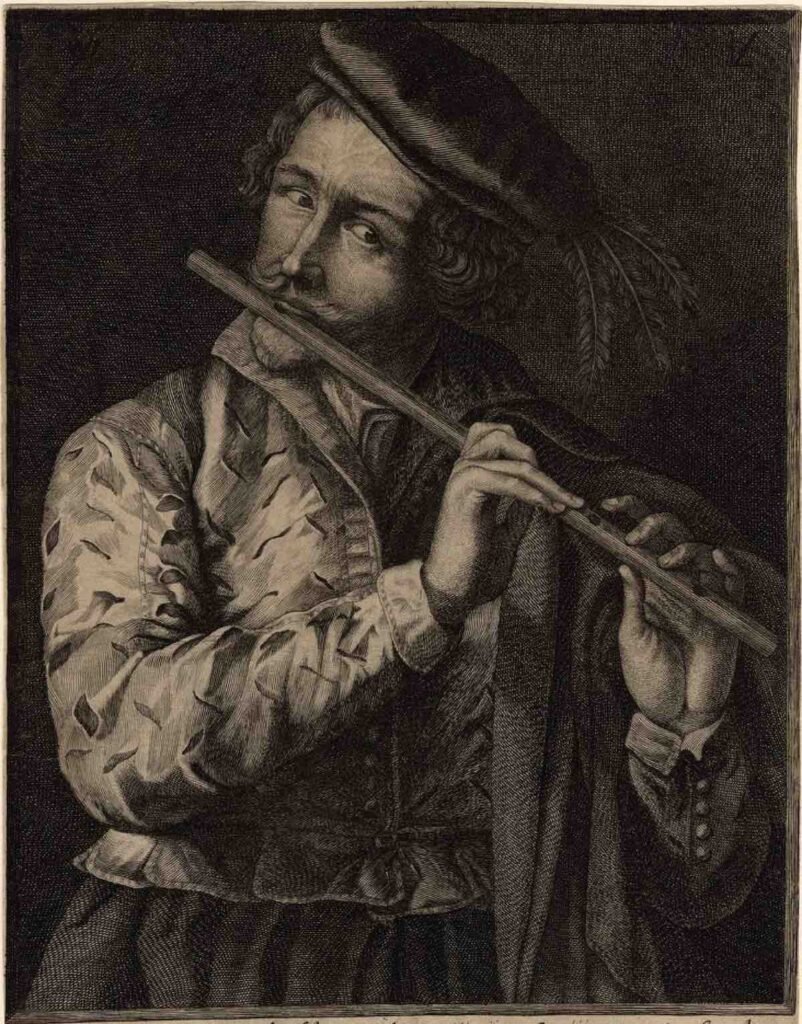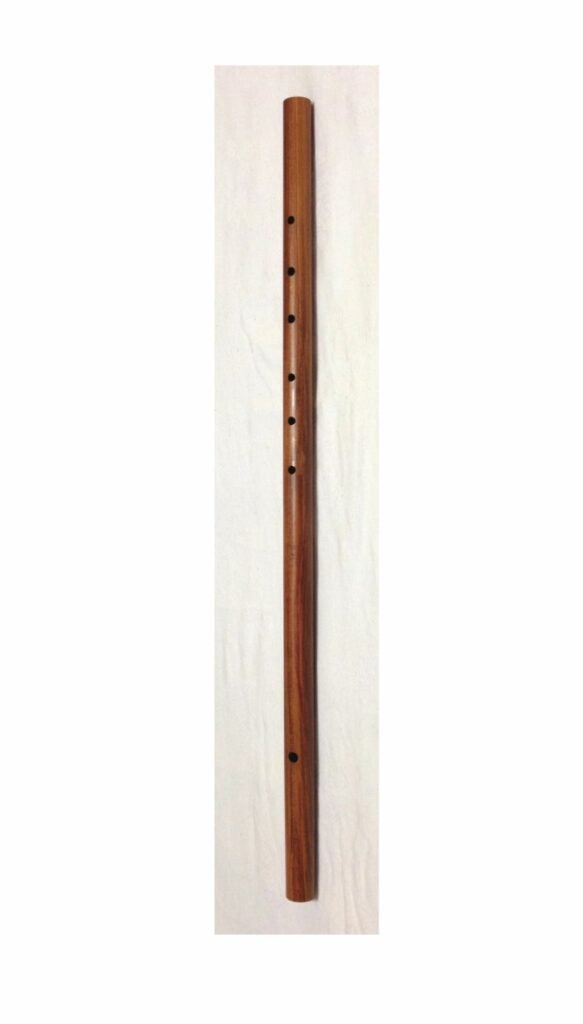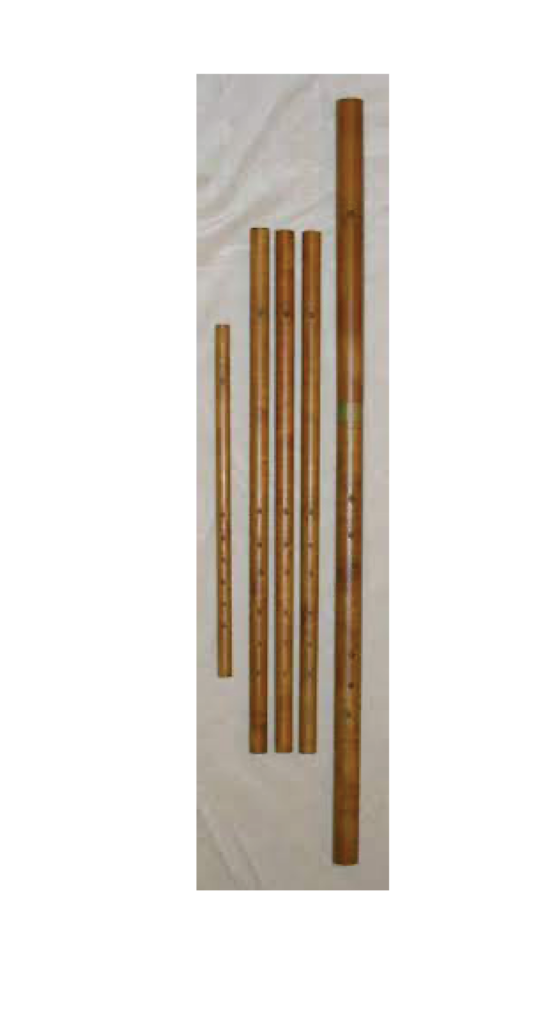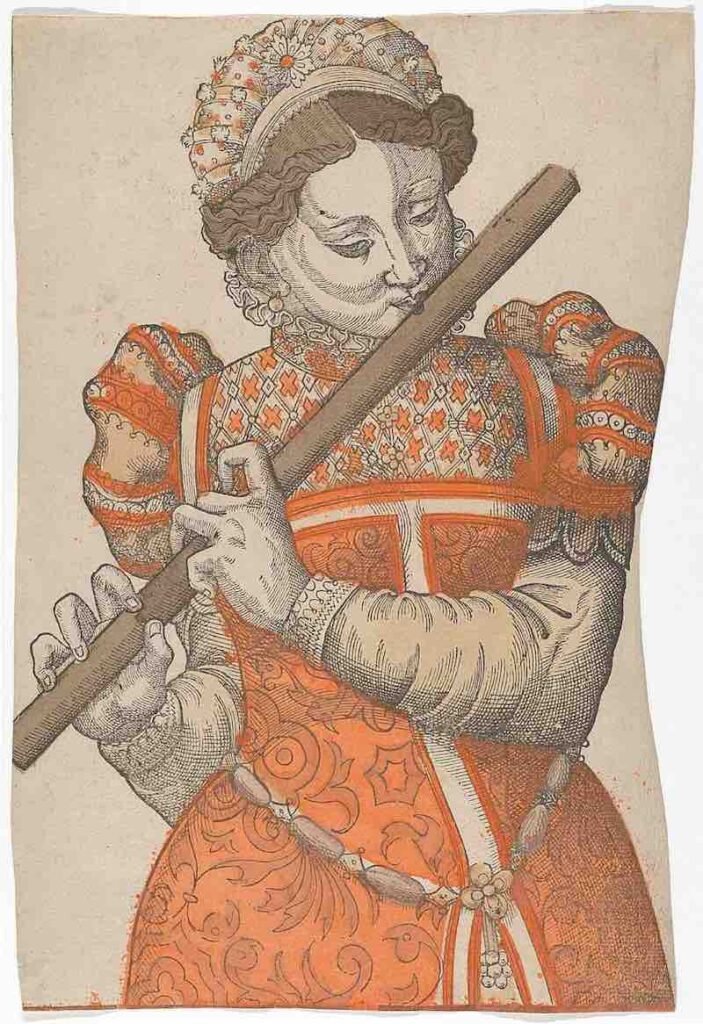The renaissance flute predated the baroque flute. The renaissance flute was a transverse flute used in Europe between 1500 until the advent of the baroque flute in 1670.

About the instrument
Information about the renaissance flute is relatively sparse. However, by observing historical construction principles, we know that the original instruments had a cylindrical bore, six finger holes and a mouth hole.
It is hard to find pictures of the flute from the fifteenth century but the instrument is seen more in the sixteenth century.

Pictures from the 16th century suggest that the flute had two uses.
- As a military instrument
- As a chamber music instrument
We can see that the flute was usually played together with other instruments within mixed ensembles but flutes also appeared as chamber groups together, without other instruments, called the flute consort.
There is a large number of flutes listed in inventories which gives an indication of the popularity of the instrument, although there are very few preserved originals.
The stuttgart court possessed 220 flutes in 1589, Henry VIII had 74 in 1547, Maria of Hungary had more that 50 in 1555, Philip II of Spain had 54 in 1598 and the Academia Filarmonica of Verona had 51 in 1628. There are not many of these instruments left but there are a few still surviving.
Most technical information about the renaissance flute come from treatises of the time, in particular Virdung, Martin Agricola and Michael Praetorius.
In 1511, Virdung was the first to examine the flute. Agricola followed on with his own discussion of the flutes playing characteristics in 1528. It was in this discussion that we first see the idea of a flute family, including bass flutes and tenor flute.
Praetorius furthered this and discussed the flute consort in his treatises. He states the flute consort as including two trebles in A, four alto tenor flutes in D and two bass flutes in G. These flutes would all be different measurements and lengths to be able to be in the stated pitch.

Where did renaissance flutes originate?
The history of renaissance flutes is documented as beginning in Germany in the Middle Ages. By the 12th century, renaissance flutes were a popular aristocratic German instrument.

By the 14th century, renaissance flutes had began to gain popularity in France. However, the flute was known so much as a German instrument that in England and Spain, the renaissance flute was referred to as the German flute.
Characteristics of the renaissance flute
Puglisi examined many of the surviving instruments and came up with certain characteristics of the renaissance flute.
- The instrument was made from one piece of wood.
- The mouth hole was usually oval in shape, inline with the length of the flute. The diameter of the mouth hole was usually smaller than what we see on baroque flutes.
- The cylindrically bored renaissance flute was thinner in the middle of the instrument and thicker towards each end.
- The finger holes are grouped into two sets of three with the spacing between each group of three holes equally spaced. However, there seems to be no stead fast rule as to which way round the hands should go.
- The instrument is very light due to the thinness of the walls.
- There are three sizes of renaissance transverse flute that are documented.
During the renaissance period there was no standard pitch. In fact, the pitch varied from place to place and from church to church. Very different to our modern pitch now!
Within the surviving flutes from this period, there does seem to be two pitch areas most frequently represented and that is A=410 and A=435. Although, there is a large group of instruments who’s range is at A=408.
Nowadays, most early music ensembles will choose to play A=415.
Take a listen to the early music consort of London.
The Range of the Renaissance flute
The instrument generally had the range of two octaves plus a fourth or fifth beyond this. However, some will also have the range of three octaves.
The range of the flute, much like the recorders of the time, are notated an octave lower than the original pitch (how it actually sounds).
The most common size of renaissance flute is the tenor renaissance flute in D. This flute was the most versatile as it could cover the range needed for most 16th century music
Within the flute consort of the renaissance period, you would also need the bass flute in G and then the brighter tone of the descant recorders in A or in G.
Use of the flute in music
When playing music of the time, the instrumentation was very rarely set in stone. Decisions on what instruments to play were made on the basis of the availability of instruments, musicians and of the taste of the performers.
It is documented that within pieces of music the renaissance flute was used in three different sizes or sometimes with a grouping of a bass flute in G with three tenor flutes in D.
The sound that the renaissance flute produces is a little more airy than that of the recorder of the time and this was why it was used more in ensembles rather than as a soloist instrument.
Repertoire
The repertoire you will tend to see for the renaissance flute will mostly be vocal music but as we progressed into the sixteenth century more purely flute music started to become available.
The earliest piece of renaissance music for flute on record is Attaingnant’s Vingt et sept chansons musicales a quatre which was published in 1533. Within this piece of renaissance music, each work is designated either for renaissance flute consort or recorder.
When starting out on the renaissance flute, Jacob Van Eyck Der Fluyten Lust-hof is the place to start. The relatively simple melodies make this very accessible to the new renaissance flute player.
Flute consort music is also a great place to start when playing renaissance flutes.
By the end of the renaissance transverse flute era, the baroque transverse flute had become firmly established throughout Europe.
For a look at how renaissance flutes sound, how a look at this video by Amanda Markwick, a historical flute specialist.
What’s next..?
- Learn about types of Flutes from Classical to Modern
- Flute vs. Recorder – A Guide to the Differences
